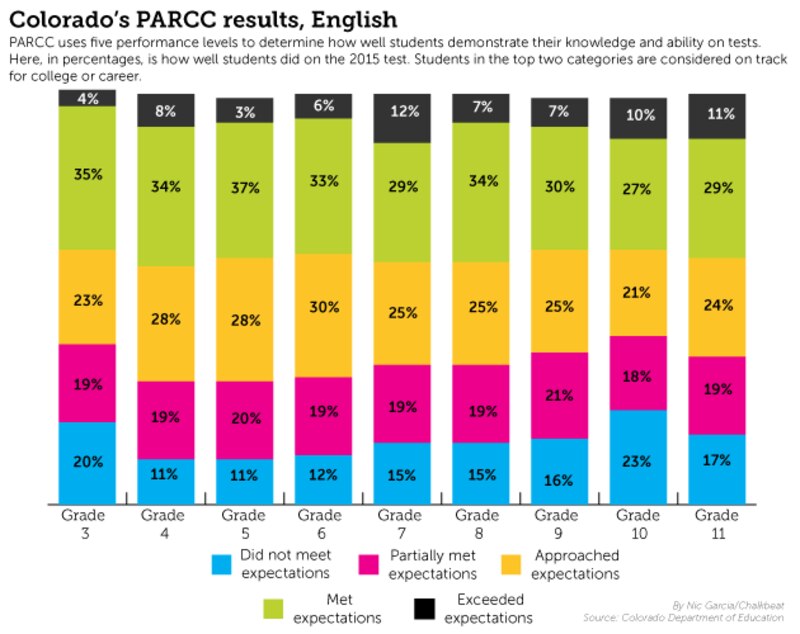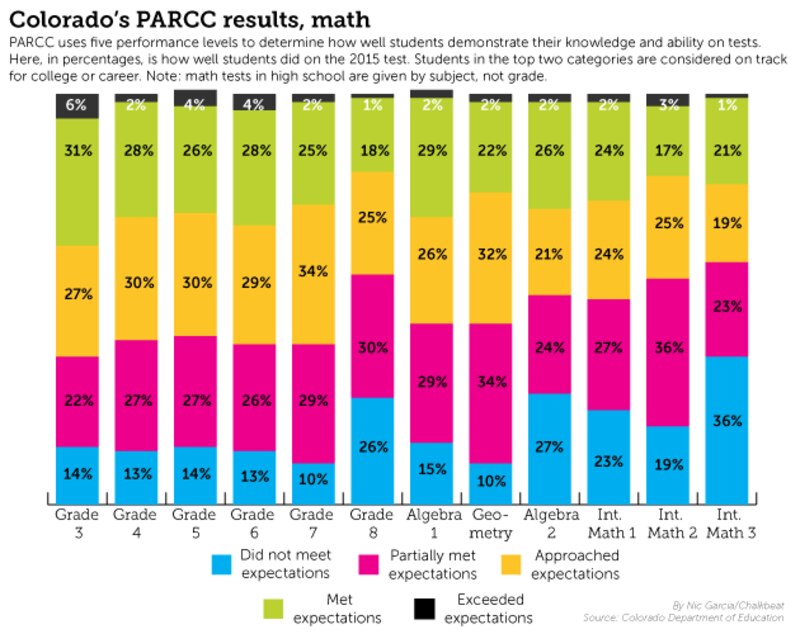Most Colorado students are far short of where they should be in English language arts and math, according to much-anticipated results of new, more difficult state tests released Thursday.
State education officials have long warned that the first round of PARCC scores covering grades three through 11 all but certainly would paint a bleak picture. Those predictions were on target.
In language arts, the percentages of Colorado students rated as meeting or exceeding expectations ranged from a high of about 43 percent in 4th grade to a low of 37 percent in 10th grade.
Students did even worse in math, with percentages ranging from about 19 percent in 8th grade to 37 percent in 3rd grade. Reaching conclusions about how older students performed is more difficult because of an array of different math tests given to students in middle and high school.
The release of the scores is a key juncture in a years-long effort to develop and put in place stronger academic standards, and introduce next-generation tests to see how students measure up.
Data Center | Search our database for PARCC results here.Unlike derided bubble tests of old, PARCC tests developed for a collective of states including Colorado pledge to reward critical thinking and problem solving with more sophisticated questions given online. The academic standards are supposed to put students on track for going to college or starting work.
Yet PARCC has been heavily criticized in some quarters, both as part of a broader backlash against standardized tests and for perceived shortcomings including lack of a proven track record.
The results made public Thursday during a state Board of Education meeting share one trait in common with their predecessors — they showed wide gaps separating students’ scores based on race and income.
Participation also was lower compared to past state tests, with overall participation rates at 82 percent in English language arts and 85 percent in math. Much of that was driven by high schoolers skipping the tests. Data released Thursday showed tens of thousands of students, most in higher grades, opted out of the PARRC tests as a result of parent refusals.
Asked about the PARCC scores after a Capitol budget briefing, Gov. John Hickenlooper said, “When we adopted these new higher standards we knew there’d be some sticker shock in the first couple of years. We’re resetting the bar.”
“The point about these higher standards is we want kids and parents to have conversations about what they want to be,” he said.
State board chairman Steve Durham, a Colorado Springs Republican, said at the board meeting that it’s impossible to tell whether the results mean the school system is a “catastrophic failure,” or whether other factors are at work.
“If you take the scores at face value, almost two-thirds of our students have failed,” he said. “I have a hard time believing that number.”

Although PARCC backers promised quicker, more meaningful results, this year’s test is an exception because of the extra work involved in an entirely new enterprise, officials say. Thursday’s announcement only covered state-level data. Not until Dec. 11 will the tests results of individual districts and schools be revealed.
Districts then will distribute individual student reports to parents, on their own timelines.
The percentages of students scoring in the top two levels on PARCC — meaning they met or exceeded expectations — are considerably lower than those achieving the top two levels on the last state tests, called TCAP.
But state education officials have repeatedly stressed that the results can’t be compared because the two sets of tests are so different in their expectations and in the academic standards on which they’re based.
“These scores don’t provide an apples-to-apples comparison to old test scores,” interim education commissioner Elliott Asp said in a statement. “The new tests measure different things – such as where students are in developing the critical-thinking and problem-solving skills outlined in the Colorado Academic Standards. We should all consider these scores as a new baseline from which we will measure the future success of Colorado students.”
State education officials have emphasized the concept of a baseline – that Colorado students and schools are starting fresh with new tests whose results and impacts will have to be reviewed over multiple years.
Other states that have switched testing systems have seen scores rise after multiple years of giving new exams. Kentucky is one example cited frequently by supporters of the standards and assessments.

Almost everything about the tests given in Colorado is new. The exams are more rigorous, they are given online — a paper-and-pencil option was available under some circumstances — and they are the first tests to be fully based on Common Core state standards in math and English.
A separate writing test — long a feature of TCAP and its predecessor, CSAP — is gone. Writing now is part of the overall language arts tests. Writing is also incorporated into math test items.
Joyce Zurkowski, executive director of assessments for the state education department, told state board members Thursday it was fair to expect that Colorado students’ scores will be low initially.
The Common Core standards were fully put into practice just last academic year, and teachers and students are still becoming familiar with them, she said. Zurkowski said scores are expected to rise over time.
The switch to the new tests is like “moving from the JV team to the varsity team,” she told reporters. “… The game is harder.”
Zurkowski also cited instances of Colorado students’ PARCC performance closely mirroring the results of other more established tests, the ACT college entrance exam and the National Assessment of Educational Progress, or NAEP. That, Zurkowski said, “allows us to have confidence in the results.”
The tougher tests, she said, are meant to stem the tide of students graduating high school ill-prepared and finding themselves stuck paying for remedial courses in college for which they receive no credit.
PARCC tests also have five levels of student achievement – exceeded expectations, met expectations, approached expectations, partially met expectations and didn’t meet expectations. The TCAP system had four levels, as do the current state science and social studies tests.
The PARCC tests also sparked significant numbers of parents and students skipping the tests altogether. While test participation by elementary school students exceeded 95 percent, student opt-out rates reached 31 percent on 11th grade math tests and 25 percent on all 10th grade math scores.
Among other highlights of the first PARCC test results:
Overall scores – Relatively small percentages of students exceeded expectations, ranging from 4 percent of third graders to 12 percent of 7th graders in language arts. The percentages were smaller for math. Six percent of third graders were at the top level, but it was only 1 or 2 percent in eight other grades. In the category of didn’t meet expectations, 10th graders recorded the highest for language arts with 23 percent. In math, 26 percent of of 8th graders didn’t meet expectations.
English and math – The percentages of students meeting or exceeding expectations in language arts generally were higher than the percentages for math. In middle and high school, 30.4 percent of students who took the algebra I test exceeded or met expectations. Those percentages were lower in the other five math tests.
Gender – Girls performed significantly better than boys on language arts tests, while the percentages in the five levels were much closer in math.
Ethnicity – The tests results showed achievement gaps between ethnic groups similar to those seen in previous tests and other measures of achievement. On the 7th grade language arts test, for example, 58.3 percent of Asian students and 51.7 percent of whites met or exceeded expectations. But 24.7 percent of Hispanics and 25.6 percent of black students were in the two top categories.
At-risk – There also were wide gaps between students eligible for free or reduced-price lunch and those who are not. In 5th grade math, for example, 14.9 percent of at-risk students met or exceeded expectations, compared to 41.9 percent of other students.
Language – English language learners are classified in different categories based on their levels of proficiency. The least-proficient students scored very poorly in general, with test performance rising significantly for more-proficient students in both language arts and math.
State Board of Education members used the platform of the PARCC release to voice familiar positions about academic standards, tests and using the results to hold schools and districts accountable.
Republican Debora Scheffel, of Parker, said she believes the tests measure language skills rather than content knowledge, dramatically disadvantaging students whose second language is English or who have not developed great vocabulary skills. Other board members made similar arguments.
A harsh critic of testing from the other side of the political spectrum, Democrat Val Flores of Denver, said the tests waste money and don’t help poor and minority students.
“Education is about teaching and learning,” she said. “It’s not about accountability. It is not about high-stakes testing.”
But Jane Goff, an Arvada Democrat, saw something positive in the stronger scores among younger students.
“These are the children who have been living the new standards and the new ways and the new strategies and techniques,” she said. “They’ve lived it. Our older grade students have not had that experience.”
On past tests, the percentage of students scoring in the top two of the four levels was an important factor in school and district ratings.
The State Board of Education hasn’t yet decided how the new five-level system will be used for accountability and may not do so until next year.
The state is in a one-year pause in use of state test results for either accountability or educator evaluation. So the test results released Thursday won’t be a factor in those things.
Proponents of the Common Core and the two multi-state tests, PARCC and Smarter Balanced, have long argued for the value of being able to accurately compare the performance of students in different states. While federal law long has required state to test in language arts and math, each state has used it own academic standards and tests.
Most of the nine active PARCC participants haven’t yet reported full results, so it’s not possible to fully compare the performance of Colorado students with those in other states.
New Jersey and New Mexico have reported data comparable to Colorado’s. Across most grades and subjects, New Jersey students performed markedly better than those in Colorado. But New Mexico trails Colorado across grades and subjects.
Learn more about the background of assessment in Colorado in Chalkbeat’s archive of testing stories.
Chalkbeat Colorado deputy bureau chief Nicholas Garcia contributed information to this report.

